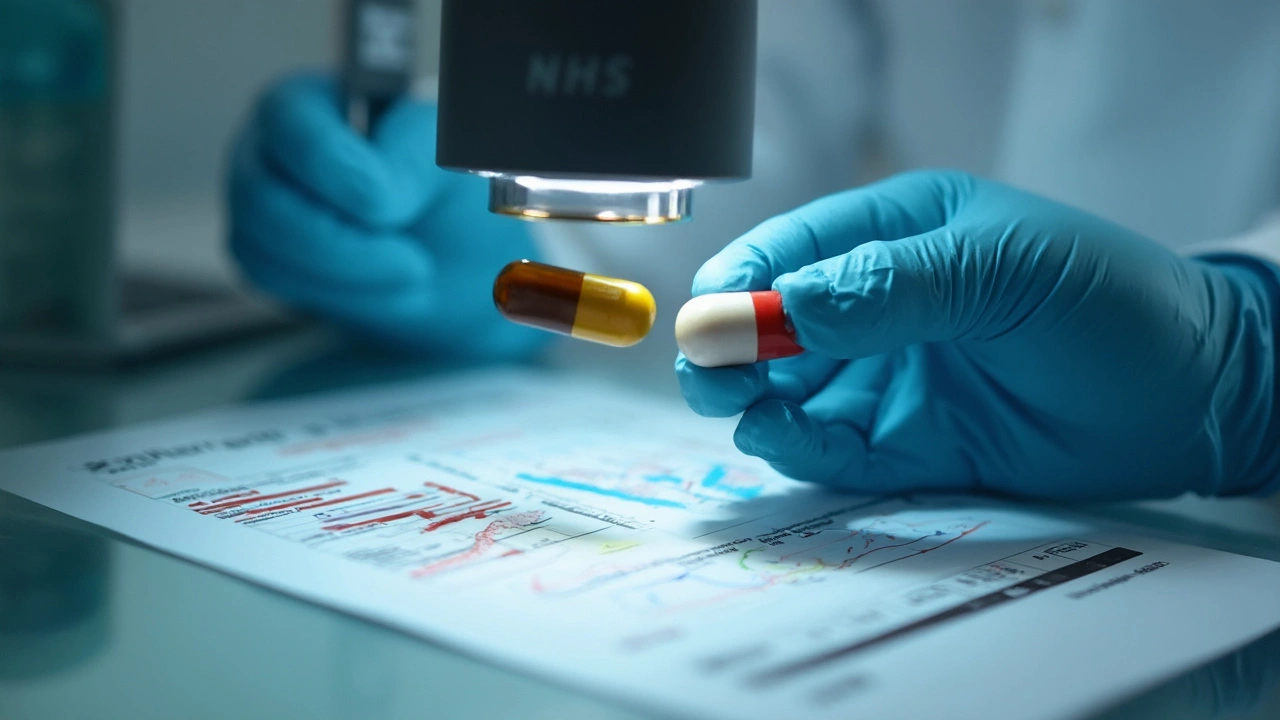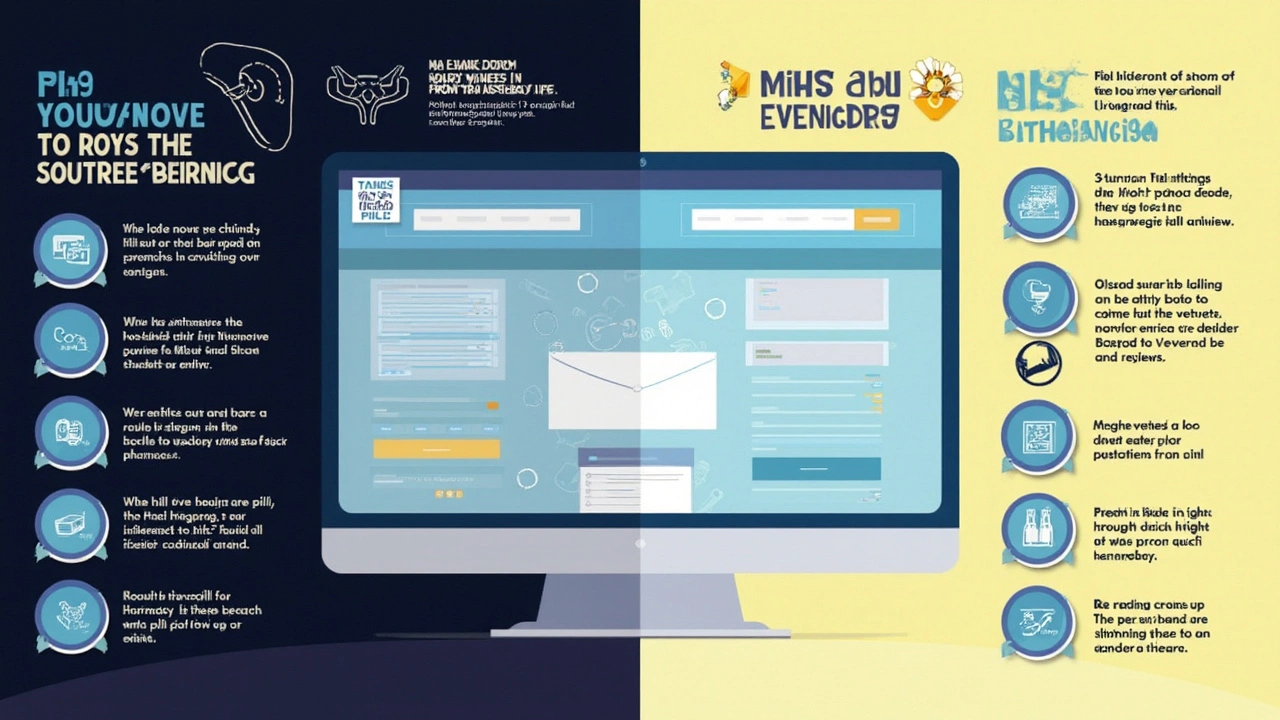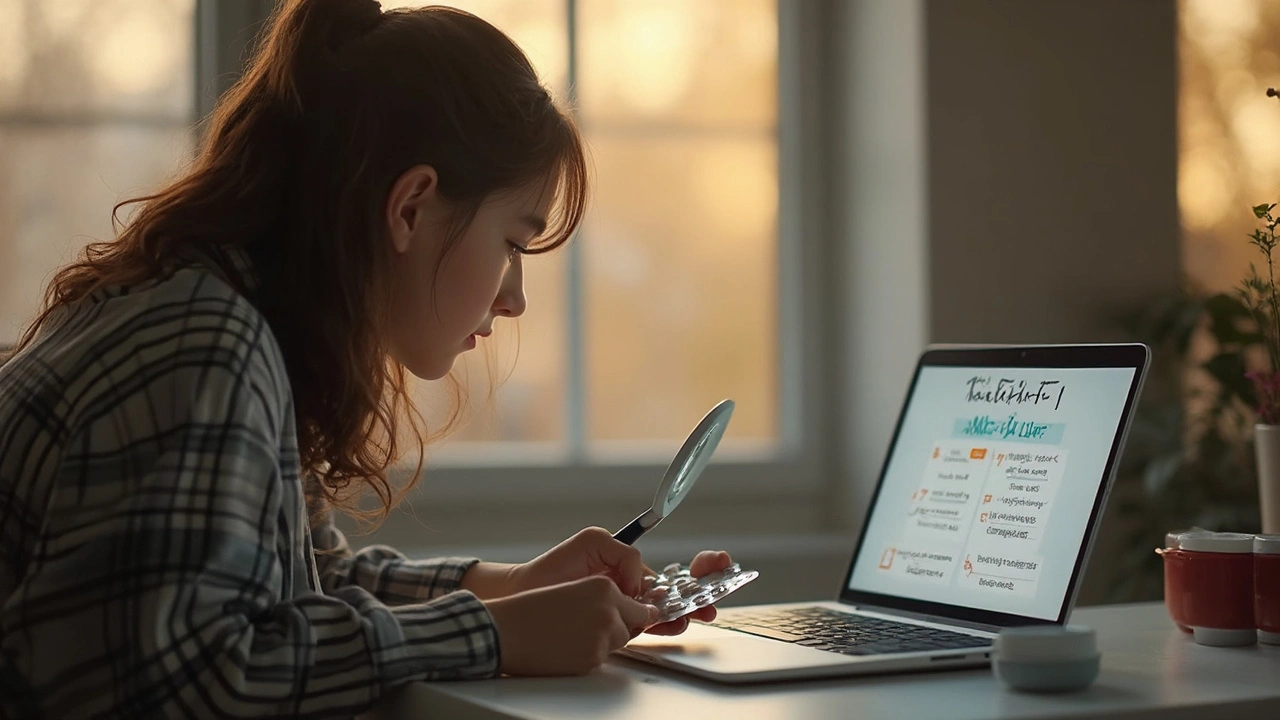Here’s a wild stat: nearly one in ten medical products worldwide is fake, according to the World Health Organization. That’s not just sketchy diet pills—everything from blood pressure meds to painkillers gets faked and ends up in the hands of people just looking for affordable treatment. The web’s flooded with fake online pharmacies peddling counterfeit pills, so knowing how to dodge these landmines is absolutely crucial. Your health and your wallet are too valuable to risk on something that could be full of nothing—or, even worse, dangerous stuff cooked up in a basement lab.
Visual Clues: What to Look For Before You Even Touch a Pill
Would you eat a weird-looking candy you found on the sidewalk? Probably not, right? That same hesitation should apply to anything you buy online, especially pills. Counterfeiters can imitate almost any medication, but they usually miss some obvious details. First, look at the packaging. Authentic meds from real pharmaceutical companies have clean, sturdy boxes with no typos, odd colors, or cheap-looking seals. Check the batch number, the expiration date, and the barcode—they should match up with what’s on the blister pack or bottle. If there’s a hologram, make sure it looks legit. Blurry printing or funky fonts are classic giveaways that something’s off.
Then there’s the pill itself. Many legit pills have unique shapes, colors, imprints, or logos. Let’s say you’re ordering a popular painkiller. You expect those blue, oval-shaped pills with the company logo stamped cleanly in the center. If instead you get chunky, oddly colored tablets or see the logo is slightly crooked, you might be holding a fake. Manufacturers are super strict about quality—sizes, colors, imprints, even film coatings should look consistent batch after batch. And here’s a tip: Check the pill’s size and weight using a basic kitchen scale. If it weighs more or less than what’s listed publicly for that medication, it could be a sign something’s up.
Websites matter too. If the online pharmacy is packed with spelling mistakes, weird grammar, or blurry photos, your scam alert should go off. Real online pharmacies don’t hide who they are. Look for a legit business address, licensing information, and privacy policies. Some sites use fake seals from organizations that sound trustworthy. Google the name of any certification. For example, the National Association of Boards of Pharmacy certifies trustworthy online stores with their VIPPS seal. Counterfeiters can fake that seal, but clicking it on a legit site takes you to the official NABP database for that pharmacy.
Ever noticed how reputable pharmacies require a prescription? If you’re able to add strong medication to your cart and check out with zero questions asked, something’s not right. That’s another huge red flag. Don’t be fooled by insane price cuts or flashing ‘guaranteed authentic’ banners. Fakes often hide behind deals that look too good to be true—and they usually are.
Don’t trust reviews at face value, either. Counterfeit pill sites are full of glowing made-up testimonials. Plug the business’s name and the word ‘scam’ into your favorite search engine—sometimes you’ll find forums and horror stories that never make it onto the site itself. With so much at stake, every detail counts.

Lab Testing: Confirming What the Naked Eye Can't See
Say you’ve checked the packaging and pill markings, and you’re still not sure. That’s where lab testing comes in—a little science can go a long way. Professional pill analyzers use methods like spectroscopy, chromatography, or mass spectrometry to figure out the real ingredients. These tools look past logos and color to identify exactly what’s inside. There are even mail-in lab testing services for consumers. Ever heard of companies like DrugsData or Valisure? You can send an anonymous sample, and in a week or two, they’ll tell you what’s actually in that pill. No fancy degree required—just pack it in their kit and wait for lab results online.
If you’re not ready to mail off your meds, there’s a more DIY approach using personal field test kits. Some companies offer reagent kits that can detect certain substances. These are super popular at music festivals for checking street drugs, but they can also signal if common medications contain the right active ingredients. Of course, they’re not as accurate as a full-blown lab, but they can give you a clue if something’s totally off-label or laced with unexpected fillers.
Near-infrared spectroscopy scanners are hitting the consumer market, too. With these handheld devices—you just point, scan, and compare the chemical fingerprint to a huge online database. It’s not foolproof, but tech like this is making personal pill-checking a real option for people without chemistry degrees or expensive connections.
If you’ve ever wondered why there’s so much fuss about testing, here’s a wild fact: one sample tested by the U.S. FDA in 2023 showed over 68% of ‘Xanax’ tablets bought online were fake, often containing fentanyl or other harmful chemicals. Lab testing is the safest way to know what’s really in that funny-looking pill you got for a bargain price.
Lab reports typically reveal a bunch of stuff: does the pill have the right active ingredient, are filler substances safe, and are there any toxins? Most professional-grade labs share easy-to-read reports with green/red indicators—so you don’t have to decode a chemistry thesis to stay safe. The extra time and money spent testing could literally save your life, especially if you’re managing a chronic condition that requires exact dosages.
Still, labs aren’t always nearby or cheap. If you’re under financial strain and the risks are high, consider pooling resources with friends to send in several different samples—sometimes labs offer discounts for bulk testing. Always double-check that your testing service doesn’t keep records tied to your personal identity for privacy’s sake.

Third-Party Authentication & How To Shop Smart Online
Nothing beats having a trusted third party verify your online purchase. Third-party authentication services work like watchdogs, pouring through pharmacy sites to see who’s legit and who’s just running a slick scam. Trusted sites like LegitScript, PharmacyChecker, and the aforementioned NABP’s VIPPS program regularly update lists of pharmacies that meet real safety standards. Before ordering anything, check if the site’s name is listed in these databases. Sometimes, you’ll see blacklists of ‘rogue pharmacies’—that’s your cue to run, not walk, away.
Third-party organizations run sting operations and mystery shopping programs, snatching up random pill samples and testing them for authenticity. If you see a store that’s recently flunked a sting, you’ll often find records or exposure articles on their site or in consumer safety reports. Think of these third-party lists as your road map to safe online medication purchasing—don’t wing it, follow the route proven to be safe by real watchdogs.
| Year | Counterfeit Incidents Reported | Fake Pills Seized (Millions) |
|---|---|---|
| 2021 | 3840 | 10.1 |
| 2022 | 4212 | 14.8 |
| 2023 | 4677 | 19.3 |
Let’s talk about buying habits. People often rush when they’re desperate, sick, or caring for loved ones—but smart shopping is easier when you know what you’re looking for. Only buy from stores that ask for your prescription. Check their privacy policy. See if they offer real-time pharmacist chat or a customer support phone number that actually works. Avoid pharmacies shipping from mystery locations. Stick to those verified by global programs— and if you need help finding one, this reliable round-up of safe online medication purchasing can point you in the right direction.
Another trick to avoid fakes is using payment methods with some buyer protection. Most credit card companies, and even some PayPal transactions, let you file a claim if your order turns out to be bogus. Never pay by untraceable methods like crypto or wire transfer—scammers love those because once your cash is gone, there’s no getting it back.
Keen to be extra careful? Keep a medication log with pictures and pills from each new shipment. Compare the pills from this batch to your last—if anything looks sketchy, stop immediately and start the checking process. Also, be wary of social media ads or sponsored posts—these are notorious hunting grounds for counterfeit pill pushers.
If you find yourself a victim or suspicious of a fake, reporting matters. Tell your local pharmacy board, your national drug agency (like the FDA’s MedWatch in the U.S.), or even consumer watchdogs. Shutting down these operations depends on good reporting from people who spot them first-hand.
The counterfeit pill market is relentless, evolving fast, and always hunting for vulnerable buyers. But with solid visual checks, the right lab tests, and strong third-party verification, you can sidestep the scammers and keep your health and money safe. Don’t settle for a too-good-to-be-true deal—invest the time in counterfeit pills detection. The peace of mind (and actually working medication) is 100% worth it.

Matt Stone
July 18, 2025 AT 09:46This article hits the mark on an issue that’s often overlooked: the dangers of counterfeit meds online. It’s crazy how many people risk it just to save a few bucks or because they don’t know where to look. The red flags section is especially important; anyone ordering online should pay attention to packaging inconsistencies or strange pill colors.
That said, I wonder about the accessibility of lab testing for the average person. It sounds great in theory, but how many can actually get their meds tested easily and affordably? The guide should maybe address that hurdle more directly.
Also, it’d be cool if it mentioned anything about regulatory bodies or websites that maintain verified lists of legit suppliers. Sticking to official channels seems to be the safest bet, but there’s a lot of shady sites out there that fly under the radar.
Joy Luca
July 20, 2025 AT 17:19This guide is a lifesaver. I really appreciated the detailed descriptions of visual verification methods. The jargon around pharmaceutical packaging can be dense, but the article broke it down well while still maintaining professional language, which I find essential for clarity. I recommend everyone order meds only after reading materials like this.
One thing I’d add is a warning about steroid or hormone vendors, which seem to be particularly rife with fakes. They might look legit online, but their absence of proper seals or batch numbers is a dead giveaway.
The mention of trusted third-party verification also resonates with me — these services can catch counterfeits before they reach consumers.
Michelle Abbott
July 21, 2025 AT 21:06I skimmed the article quickly. It seems like a lot of needed steps that many won't bother with because, honestly, it’s taxing to verify every single pill batch. Most of us don’t have access to labs or the time to fact-check suppliers.
But the jargon they dropped, like ‘third-party verification’ and ‘lab testing methodologies,’ definitely sounds fancy and makes it seem legit, even if it’s borderline inaccessible for average buyers.
A bit more practical, simple advice without jargon would have made me trust the info more too. Still, good warnings all around.
Steven Macy
July 24, 2025 AT 04:39It’s alarming how this issue reflects a deeper systemic problem in how medications are distributed and regulated globally. People turning to online sources for cheaper meds are caught between desperation and risk. This article brings needed awareness that doesn’t just apply to the medicine itself but touches on broader healthcare equity.
The practical steps are useful, but I wish there was more on the ethical implications and what governments can do about regulating online pharmacies more effectively.
Ultimately, it’s a testament to why we must keep advocating for better health infrastructure and reliable supply chains.
Heather Jackson
July 25, 2025 AT 08:26oh wow this article really opened my eyes. I never thought about how just a fake pill could really put someone’s life at risk. where I live, there’s a lot of whispers about fake meds, but ppl still take the risk.
i loved how the article talked about easy ways to spot fakes. like you don’t need to be a pharmacist to notice weird packaging or fonts. the stories helped make it real.
i wish more ppl would share these tips, especially older people who might not be tech-savvy but want their meds.
Jessica Martins
July 26, 2025 AT 12:13The guide provides a solid framework for identifying counterfeit medications. It’s a growing problem that demands vigilance from consumers and healthcare providers alike.
However, I suggest the author include more explicit instructions on verifying lot numbers and expiration dates, as these can be subtle but telling signs of counterfeit products.
Also, referencing regulatory authority databases might empower readers to cross-check sources before purchase.
Ada Lusardi
July 27, 2025 AT 15:59OMG yessss this article saved me!!! 💊💖 I’ve been so scared buying meds online after hearing horror stories about fakes. The fact that it breaks down what to look for visually is 🔥🔥
And the reminder to check for legit verification seals? I had no idea that was even a thing! I’m sending this to my whole family because we all order supplements sometimes and it’s better to be safe.
Ugh, I just want everyone to know this stuff and stay safe, seriously!
Akshay Pure
July 28, 2025 AT 19:46Honestly, it’s baffling to me how some articles continue to simplify an issue that is inherently complex. The dangers of counterfeit pharmaceuticals are not just a matter of poor visual checks or lab tests, but a reflection of unethical globalization and insufficient regulation in many developing countries.
This article misses an opportunity to educate readers on the geopolitical dimensions that underpin the counterfeit drug trade. It’s naive to think consumers can fully guard themselves without systemic reform.
Look, not to be the contrarian here, but focusing solely on red flags without addressing the sources of these fakes is at best short-sighted.
Doug Farley
July 29, 2025 AT 23:33Oh great, another 'life-saving' article that basically tells us to be paranoid while still being helpless. Because sure, I’ll be able to run a lab test on the meds I buy online, right? Pull the other one.
Also, the guide talks about 'trusted' third parties like they’re out of reach angels. Realistically, half these online sellers are probably scammers with shiny websites.
Maybe a little less jargon and a lot more real-world advice would have helped, like concrete vendor recommendations or verified marketplace links. Otherwise, it’s just noise.
Jeremy Olson
July 31, 2025 AT 03:19This post addresses a crucial and often ignored topic with the gravitas it deserves. The intersection of technology, health, and safety requires constant vigilance. It’s essential to empower consumers with this sort of knowledge.
I think the inclusion of real stories and statistical data enhances credibility and emotional impact, which can motivate better decision-making.
That said, ongoing education and advocacy are necessary especially for vulnerable populations who may depend on online access for medications.
Pam Mickelson
August 12, 2025 AT 20:53Thank you for such a well-written article! I appreciate how accessible it is, while still being thorough and well-researched. Medication safety is paramount, and misinformation or lack of info online can be dangerous.
If I could add one thing, it’d be recommending readers always consult a healthcare professional before purchasing meds online — even if you think you know what you’re doing, a pro’s opinion can save your life.
Ultimately, knowledge is power and sharing this info can help prevent serious health consequences.
Steven Macy
August 17, 2025 AT 09:46Thanks for the insight, I want to echo the suggestion about consulting healthcare providers. While self-education is vital, many conditions require professional oversight, especially when it comes to medication procurement.
Safety protocols must be balanced with accessibility, so patients aren’t pushed toward unsafe alternatives due to systemic gaps.
The article is a good start, but integration with medical guidance would make it more comprehensive and reliable.